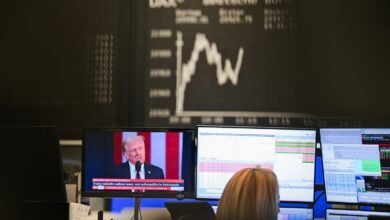The focus is on earnings, higher bond yields in Japan and a weakening dollar.
European stocks are higher on Tuesday and are fading the weakness triggered by the US debt downgrade. The focus is on earnings, higher bond yields in Japan and a weakening dollar. Monday’s wobble in US stocks did not trigger a move higher in the Vix index, which suggests that volatility is low, risk sentiment remains high and global stocks can continue to recover, even if US equity market futures are pointing to a lower open later today.
S&P 500 back in bull market
US stock indices managed to eke out gains on Monday and put the news of the US credit rating downgrade behind them. The S&P 500 is higher by nearly 20% since its April low, which opens the door to a move back above 6,000 towards record highs from February. However, the CEO of JP Morgan said yesterday that investors are being complacent about the risks that are still lurking. So, what are these risks?
Bond market flare ups pose risk for stock markets
Possibly the biggest risk is the sporadic pressure on bond yields. This is an issue that has hurt the UK in the past, it is weighing on the US right now, and Japan is also coming under the spotlight. Long term Japanese bonds are the worst performers in the developed market this week. The 30-year yield is higher by 26 basis points, and by 15 basis points on Tuesday. The 30-year yield is now at its highest level for more than 25 years. So why the pressure on Japan’s bond yields? The reason was a difficult bond auction earlier on Tuesday. The Japanese treasury sold 20-year bonds with a lower bid-to-cover ratio than the previous auction, and a higher average yield at 2.45%, vs. 2.34% previously.
Bond investors cause mischief for global markets
The move In Japan’s long end yields is fueling demand for US 30-year Treasury yields, which are acting like a haven on Tuesday. The 30-year Treasury yield is lower by more than 10 basis points on Tuesday and is back below the key 5% level, reversing Monday’s jump higher in US yields. The pressure on both Japanese and US bonds this week is a sign bond traders are willing to punish high debt nations with large deficits. Japan has run a persistent budget deficit since the 1960s, and its debt to GDP ratio is more than 260% of GDP. This has never been a problem before, partly because the Bank of Japan had an official zero interest rate policy for many years, and because the BOJ was buying up huge amount of JGBs. The Bank of Japan’s balance sheet is more than 100% of Japanese GDP.
However, the BOJ is now looking to raise interest rates and to scale back its purchases of government debt. Today’s auction suggests that there may not be a sizeable number of willing buyers to take the BOJ’s place, which could push up yields and potentially cause some disorder in the Japanese bond market.
The focus is now shifting to the bond market, which is worth watching closely. Failed bond auctions and a sharp rise in bond yields, could filter down into weaker equities over time. That is not a problem for today, however, the bond market is one of the key risks for stocks this year.
Yen gets a boost from rising bond yields
The upward pressure from Japan’s bond yields is giving the yen a boost, and it is one of the top performing currencies in the G10 FX space. USD/JPY has now fallen through the 50-day sma, which suggests that short term momentum is to the downside, and it could open the way to 140.00.
The risk for the global economy is the spillover effects from rising yields in Japan to elsewhere. As you can see in the chart below, Japan’s 30-year yields have been rising at a much faster pace than the US, UK and Germany. This is to be expected, as the BOJ normalizes monetary policy. However, the UK, Germany and the US have all seen rising long end yields over the past year. If this continues, or if the pace of gains rise, that is when the problems begin.
Chart 1: UK, US, Japan and German 30-year bond yields, normalized to show how they move together.

Source: XTB and Bloomberg
Diverging central bank stances also weighs on bonds
US yields could be at risk from a hawkish Fed. The Fed’s John Williams said that he does not see a rate cut coming before September, while Raphael Bostic is leaning towards just one cut for this year, there is currently just over two cuts expected for this year by the Fed Fund Futures market. So far, this is not having an impact on US Treasury yields. Wednesday’s inflation report in the UK could also have some impact on the Gilt market if inflation rises more than expected.
European bonds have outperformed their global peers in the past month, largely because the ECB has been willing to cut rates, and they are expected to cut rates again in June. This downward pressure on yields may help European stocks to continue to outperform their US counterparts for the rest of this year. It may also limit euro upside, which has, so far, failed to extend gains above $1.13.
The material on this page does not constitute financial advice and does not take into account your level of understanding, investment objectives, financial situation or any other specific needs. All information provided, including opinions, market research, mathematical results and technical analyzes published on the Website or transmitted To you by other means, it is provided for information purposes only and should in no way be construed as an offer or solicitation for a transaction in any financial instrument, nor should the information provided be construed as advice of a legal or financial nature on which any investment decisions you make should be based exclusively To your level of understanding, investment objectives, financial situation, or other specific needs, any decision to act on the information published on the Website or sent to you by other means is entirely at your own risk if you In doubt or unsure about your understanding of a particular product, instrument, service or transaction, you should seek professional or legal advice before trading. Investing in CFDs carries a high level of risk, as they are leveraged products and have small movements Often the market can result in much larger movements in the value of your investment, and this can work against you or in your favor. Please ensure you fully understand the risks involved, taking into account investments objectives and level of experience, before trading and, if necessary, seek independent advice.







